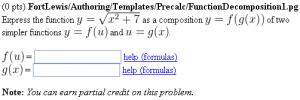Difference between revisions of "FunctionDecomposition1"
(add historical tag and give links to newer problems.) |
|||
| (One intermediate revision by the same user not shown) | |||
| Line 1: | Line 1: | ||
| + | {{historical}} |
||
| + | |||
| + | <p style="font-size: 120%;font-weight:bold">This problem has been replaced with [https://openwebwork.github.io/pg-docs/sample-problems/Algebra/FunctionDecomposition.html a newer version of this problem]</p> |
||
| + | |||
| + | |||
<h2>Function Decomposition</h2> |
<h2>Function Decomposition</h2> |
||
| Line 17: | Line 22: | ||
<tr valign="top"> |
<tr valign="top"> |
||
| − | <th style="width: |
+ | <th style="width: 50%"> PG problem file </th> |
<th> Explanation </th> |
<th> Explanation </th> |
||
</tr> |
</tr> |
||
Latest revision as of 06:04, 18 July 2023
This problem has been replaced with a newer version of this problem
Function Decomposition
This PG code shows how to check student answers that are a composition of functions.
- File location in OPL: FortLewis/Authoring/Templates/Precalc/FunctionDecomposition1.pg
- PGML location in OPL: FortLewis/Authoring/Templates/Precalc/FunctionDecomposition1_PGML.pg
| PG problem file | Explanation |
|---|---|
|
Problem tagging: |
|
DOCUMENT(); loadMacros( 'PGstandard.pl', 'MathObjects.pl', 'answerComposition.pl', 'PGML.pl', 'PGcourse.pl' ); TEXT(beginproblem()); |
Initialization:
We need to include the macros file |
Context("Numeric");
Context()->variables->add(u=>"Real");
$a = random(2,9,1);
$f = Formula("sqrt(u)");
$g = Formula("x^2+$a");
|
Setup: |
BEGIN_PGML
Express the function [` y = \sqrt{ x^2 + [$a] } `]
as a composition [` y = f(g(x)) `] of two simpler
functions [` y = f(u) `] and [` u = g(x) `].
+ [` f(u) = `] [_______________]
+ [` g(x) = `] [_______________]
[@ helpLink('formula') @]*
END_PGML
|
Main Text: |
$showPartialCorrectAnswers = 1; COMPOSITION_ANS( $f, $g, vars=>['u','x'], showVariableHints=>1); |
Answer Evaluation:
We use the |
BEGIN_PGML_SOLUTION Solution explanation goes here. END_PGML_SOLUTION ENDDOCUMENT(); |
Solution: |
